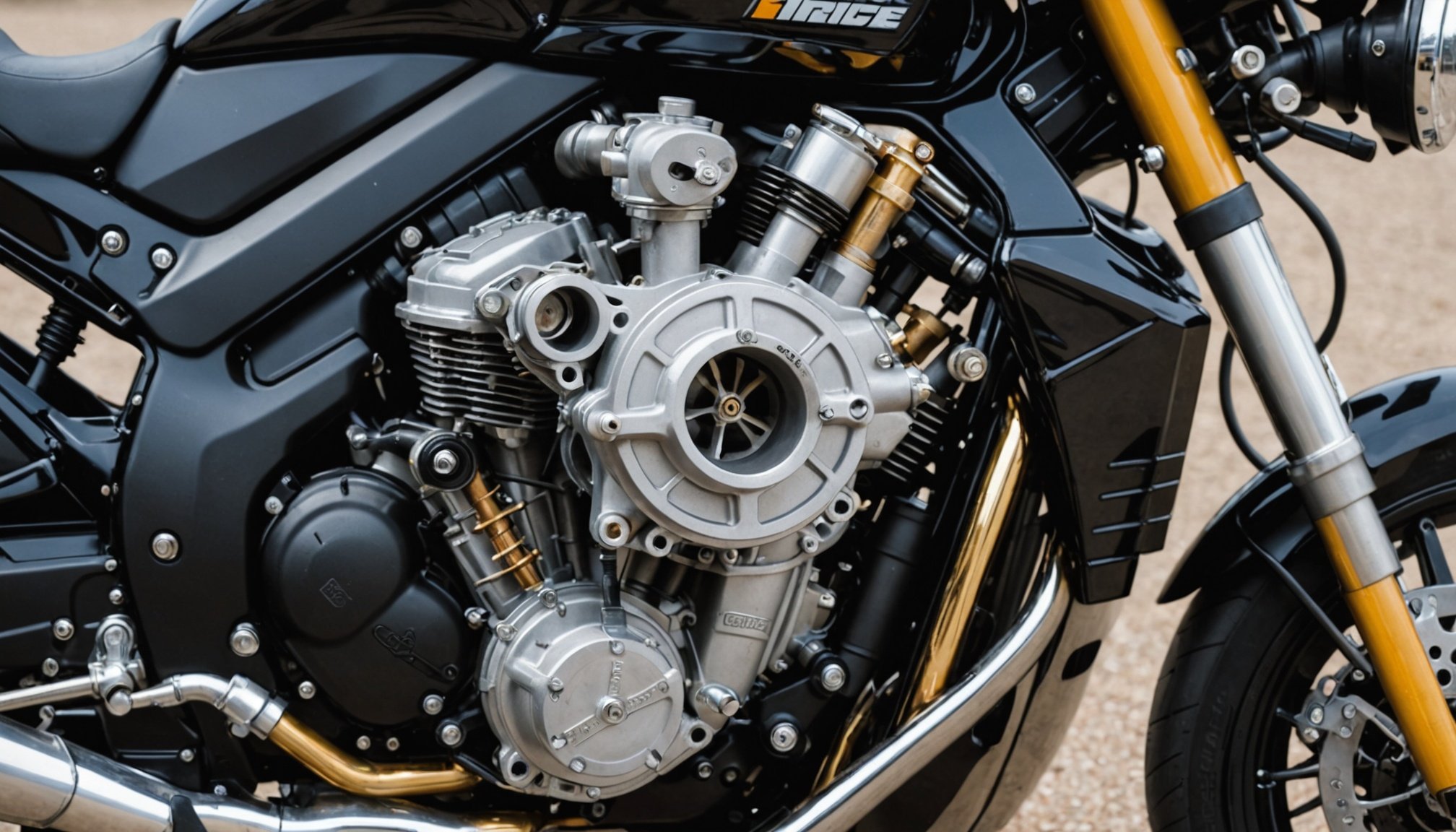Optimizing sport bike carburetors for varying altitudes in the UK requires a tailored approach. Changes in elevation can significantly affect engine performance due to differences in air density. Riders may experience issues such as stalling or loss of power without proper adjustments. This guide will explore top strategies to fine-tune carburetors, addressing air-fuel mixture and jet selection. Equip your bike for peak performance and enhance your riding experience across the diverse UK landscape.
Understanding Carburetor Functionality at Various Altitudes
Understanding how carburetor functionality is influenced by altitude effects is crucial for maintaining optimal sport bike performance. At varying altitudes, the air density changes, which directly impacts the air-to-fuel mixture that a carburetor delivers to the engine. This is essential for riders who frequently travel through different terrains, as the performance of their bikes can significantly vary.
In the same genre : Ultimate Guide to Meeting UK Emissions Standards for Sport Bikes: Tips and Techniques
Impact of Altitude on Air Density and Fuel Mixture
At higher altitudes, the air becomes less dense, meaning there are fewer oxygen molecules in a given volume of air. This reduction in air density can lead to a richer fuel mixture, as the carburetor continues to deliver the same amount of fuel despite the decrease in available oxygen. Conversely, at lower altitudes, the air is denser, potentially causing a leaner mixture.
Carburetor Components and Altitude Adaptation
Several components within a carburetor are designed to adjust the fuel mixture to accommodate different altitudes. The jet needle, main jet, and pilot jet are particularly crucial in this process. These components can be adjusted or replaced to ensure that the carburetor delivers the optimal mixture for the prevailing altitude. Understanding how to tweak these parts can help riders maintain consistent performance across various altitudes.
Also to discover : Exploring the Impact of Lane Splitting Regulations on UK Sport Bike Enthusiasts
Importance of Local Altitude Variations in the UK
In the UK, local altitude variations can be less pronounced than in mountainous regions, but they still matter for sport bike performance. Riders should be aware of the altitude of their usual routes and any significant changes they might encounter. This knowledge allows for preemptive adjustments to the carburetor, ensuring the bike runs efficiently and effectively.
- Key Considerations:
- Regularly monitor altitude changes.
- Adjust carburetor settings as needed.
- Maintain a balance between fuel economy and performance.
By understanding these factors, riders can better manage the altitude effects on their carburetors, ensuring their bikes perform optimally in any environment.
Key Adjustments for Carburetor Optimization
Carburetor adjustments are essential for ensuring optimal performance, especially when navigating through varying altitudes. By tuning carburetors effectively, riders can maintain the balance between power and efficiency.
Jetting Modifications
When considering jetting modifications, the main jet and pilot jet are critical components for altitude tuning. Adjusting these jets allows the carburetor to deliver the correct air-to-fuel mixture. For instance, at higher altitudes, a smaller main jet might be necessary to prevent a rich mixture, while at lower altitudes, a larger jet could be beneficial.
- Main Jet Adjustments: Smaller jets for high altitudes, larger for low altitudes.
- Pilot Jet Adjustments: Fine-tunes the idle and low-speed performance.
- Recommended Jet Sizes: Consult your bike’s manual for specific recommendations.
Determining the correct jetting for your specific bike involves testing and observing performance changes. The ideal setup often requires a balance of trial and error, considering both the altitude and the bike's unique characteristics.
Air-Fuel Mixture Adjustments
Adjusting the air-fuel mixture is crucial for maintaining engine efficiency across different altitudes. Mixture screws play a significant role in this process, allowing for precise tuning. Achieving the ideal air-fuel ratio ensures that the engine runs smoothly and efficiently, regardless of elevation.
- Mixture Screw Adjustments: Key for altitude changes; adjust for optimal performance.
- Ideal Air-Fuel Ratio: Typically around 14.7:1 for gasoline engines.
- Fuel Type Impact: Different fuels can affect carburetor performance and may require specific adjustments.
Throttle Position Sensor Configuration
The throttle position sensor (TPS) plays a pivotal role in carburetor performance, especially in response to altitude changes. By adjusting the throttle position, riders can enhance responsiveness and ensure smoother transitions in power delivery.
- Role of TPS: Monitors throttle position to adjust fuel delivery.
- Improved Responsiveness: Fine-tune for better performance at various altitudes.
- Calibration Tips: Regular calibration ensures accurate readings and optimal bike performance.
By focusing on these key aspects of carburetor adjustments, riders can effectively tune their bikes for any altitude, ensuring consistent performance and reliability.
Tools and Equipment for Carburetor Tuning
Understanding the right tools and equipment for carburetor tuning is essential for anyone looking to optimize their sport bike's performance. With the correct gear, you can perform DIY tuning with confidence and precision.
Essential Tools for Carburetor Tuning
To effectively tune a carburetor, a set of essential tools is necessary. These include:
- Screwdrivers: Both flathead and Phillips for adjusting screws and jets.
- Jet Wrench: Specifically designed for removing and replacing carburetor jets.
- Vacuum Gauge: Helps in balancing the carburetors accurately.
- Fuel Pressure Tester: Ensures the fuel system is delivering the correct pressure.
These tools are fundamental for any tuning task, allowing precise adjustments to the carburetor components.
Recommended Tuning Kits for Sport Bike Enthusiasts
For sport bike enthusiasts seeking to perform DIY tuning, several tuning kits are recommended. These kits often include a variety of jets, needles, and other components necessary for adjusting the carburetor to different altitudes and performance requirements. A popular choice among bikers is the Dynojet Kit, known for its comprehensive selection and ease of use. Such kits provide the flexibility needed to fine-tune the air-to-fuel mixture for optimal performance.
Importance of Precision Instruments
Precision instruments play a crucial role in achieving accurate carburetor tuning. Utilizing high-quality tools ensures that adjustments are made with exactness, leading to better engine efficiency and performance. For example, a digital caliper can be invaluable when measuring jet sizes or needle positions. As the saying goes, "Precision is the key to performance," emphasizing the importance of meticulous tuning.
By equipping yourself with the right tools and kits, you can confidently undertake carburetor tuning, ensuring your sport bike performs at its best across various altitudes.
Common Challenges and Solutions
Understanding the intricacies of carburetor issues related to altitude can be daunting. However, identifying these challenges and implementing effective solutions is crucial for maintaining optimal bike performance.
Frequent Problems in Carburetor Adjustments
When adjusting carburetors for altitude, riders often encounter specific issues that can hinder performance.
- Fuel Starvation: At higher altitudes, reduced air pressure can lead to insufficient fuel delivery, causing the engine to run lean.
- Over-Rich Conditions: Conversely, at lower altitudes, the air density increases, potentially resulting in an overly rich fuel mixture.
- Inconsistent Idle: Variability in altitude can cause fluctuations in idle speed, affecting overall ride smoothness.
Solutions for Altitude Challenges
Addressing these problems requires a strategic approach to carburetor tuning.
- Jet Adjustments: Modify the main jet and pilot jet sizes to balance the air-fuel mixture according to altitude changes.
- Mixture Screws: Fine-tune these screws to achieve the ideal air-to-fuel ratio, ensuring efficient engine operation.
- Throttle Position Sensor Calibration: Regularly calibrate the TPS to maintain accurate fuel delivery and enhance throttle response.
Troubleshooting Tips for UK Environments
The UK's varied landscapes demand specific strategies for carburetor troubleshooting.
- Monitor Local Altitude: Keep track of altitude changes during rides to anticipate necessary carburetor adjustments.
- Regular Maintenance: Consistent upkeep of carburetor components can prevent altitude-related issues from escalating.
- Consult Manuals: Use your bike's manual for guidance on recommended jet sizes and settings tailored to local conditions.
By understanding these carburetor issues and implementing targeted solutions, riders can effectively navigate altitude challenges, ensuring their sport bikes perform optimally.
Expert Tips and Best Practices
Gaining insights from experienced mechanics and tuners can significantly enhance carburetor performance.
Insights from Experienced Mechanics
When it comes to optimizing carburetors, expert tuners emphasize the importance of understanding the specific needs of your bike. A seasoned mechanic might suggest, "Always start with the basics—ensure your fuel lines are clear and the carburetor is clean." This foundational advice is crucial for maintaining efficiency at varying altitudes. Regular inspections can prevent common issues such as fuel blockages or air leaks, which can severely impact performance.
Best Practices for Carburetor Efficacy
Maintaining the efficacy of your carburetor involves adhering to best practices that ensure consistent performance. Experts recommend:
- Regular Cleaning: Prevents build-up that can affect air-fuel mixture.
- Periodic Adjustments: Adjust jets and mixture screws based on altitude changes.
- Routine Checks: Inspect for wear and tear, replacing parts as needed.
These practices help sustain optimal performance, particularly when navigating through different altitudes.
Recommended Periodic Checks and Adjustments
For sustained performance enhancement, periodic checks and adjustments are essential. Experienced tuners suggest a schedule for routine maintenance:
| Check Type | Frequency | Purpose |
|---|---|---|
| Jet Inspection | Every 6 months | Ensures proper air-fuel mixture |
| Mixture Screw Tuning | Quarterly | Maintains engine efficiency |
| Throttle Calibration | Biannually | Enhances throttle response and accuracy |
Adhering to this schedule not only prolongs the lifespan of the carburetor but also keeps your bike performing at its peak across various altitudes. By implementing these expert tips and best practices, riders can confidently manage their carburetors for optimal performance.











